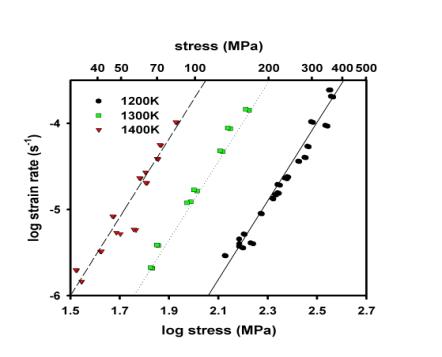

Magnesiowüstite with a composition near Mg0.8Fe0.2O is believed to be mechanically the weakest of the major constituents within the Earth's lower mantle. It is therefore likely to be an important phase during the deformation of the Earth's interior. Despite the importance of magnesiowüstite and the advantage that it is one of the few mantle phases that is stable under both deep mantle conditions and experimentally tractable conditions, there has been relatively little detailed work performed on its rheological behaviour. The tests reported here provide, to our knowledge, the first well-characterized description of the flow behaviour of magnesiowüstite with a nominal composition of Mg0.8Fe0.2O. In addition, the study allows the investigation of the evolution of microstructural features with mechanical behaviour.
The deformation experiments were performed in our high-pressure, high-temperature Paterson deformation apparatus on synthetic polycrystalline samples of magnesiowüstite. The samples were fabricated from Mg0.8Fe0.2O powder, which was prepared from mixtures of Fe2O3 and MgO reacted under controlled temperature and oxygen fugacity conditions. These powders were isostatically hot pressed under controlled conditions at high pressure and temperature to generate nominally fully dense samples with equant grains of ~40 µm size.
Suites of constant-stress and stress-stepping axial deformation experiments were performed under
the following range of conditions: confining pressure of 300 MPa, temperatures
from 1000 to 1400 K, and axial strain rates of 10-4 to 10-7
s-1 (Fig. 3.1-2a). A further set of temperature-stepping tests
was performed between 1050 and 1200 K in order to determine activation
energies for creep from individual samples (Fig. 3.1-2b). In all cases
the oxygen activity was buffered near Fe/FeO by oxidation of the iron jacket.
The results of the deformation tests can be summarized by a power law equation
of the form:  where
where  is the strain rate (s-1),
is the strain rate (s-1),  is the differential stress and T is the temperature. Values for the
empirical constants, A, the pre-exponential term, n, the stress exponent,
and Q, the activation energy for creep, were determined from fits of this
equation to the data. Based on the results of all experiments, the
calculated values are A = 2.4×10-24 s-1 MPa-n,
n = 4.0 ± 0.2, and Q = 327 ± 5 kJ mol-1. R is
the gas constant. These results are consistent with deformation by dislocation
creep and indicate that magnesiowüstite is a relatively weak material,
deforming readily in the laboratory at temperatures less than half the
melting temperature. Sample microstructures show some grain flattening
and grain refinement, plus the development of subgrains due to accumulation
of dislocations into cell walls, which is consistent with deformation in
the dislocation creep field.
is the differential stress and T is the temperature. Values for the
empirical constants, A, the pre-exponential term, n, the stress exponent,
and Q, the activation energy for creep, were determined from fits of this
equation to the data. Based on the results of all experiments, the
calculated values are A = 2.4×10-24 s-1 MPa-n,
n = 4.0 ± 0.2, and Q = 327 ± 5 kJ mol-1. R is
the gas constant. These results are consistent with deformation by dislocation
creep and indicate that magnesiowüstite is a relatively weak material,
deforming readily in the laboratory at temperatures less than half the
melting temperature. Sample microstructures show some grain flattening
and grain refinement, plus the development of subgrains due to accumulation
of dislocations into cell walls, which is consistent with deformation in
the dislocation creep field.
 |
 |

Tel: +49-(0) 921 55 3700 / 3766, Fax: +49-(0) 921 55 3769, E-mail: bayerisches.geoinstitut(at)uni-bayreuth.de
 Previous page
Previous page